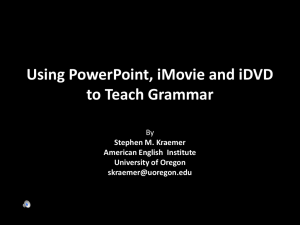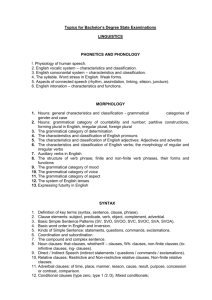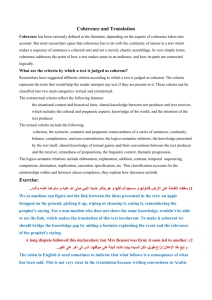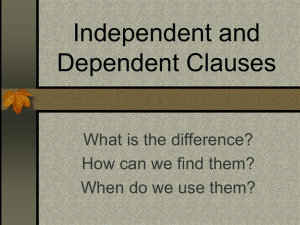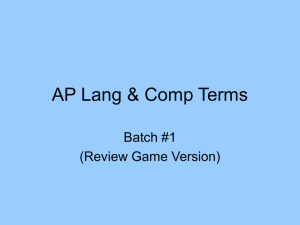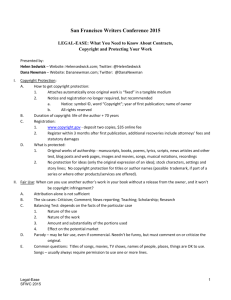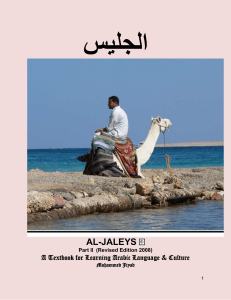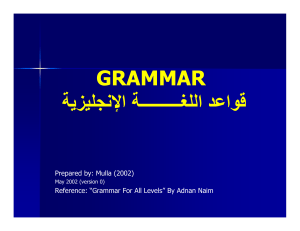Chapter 5: Stylistic analysis
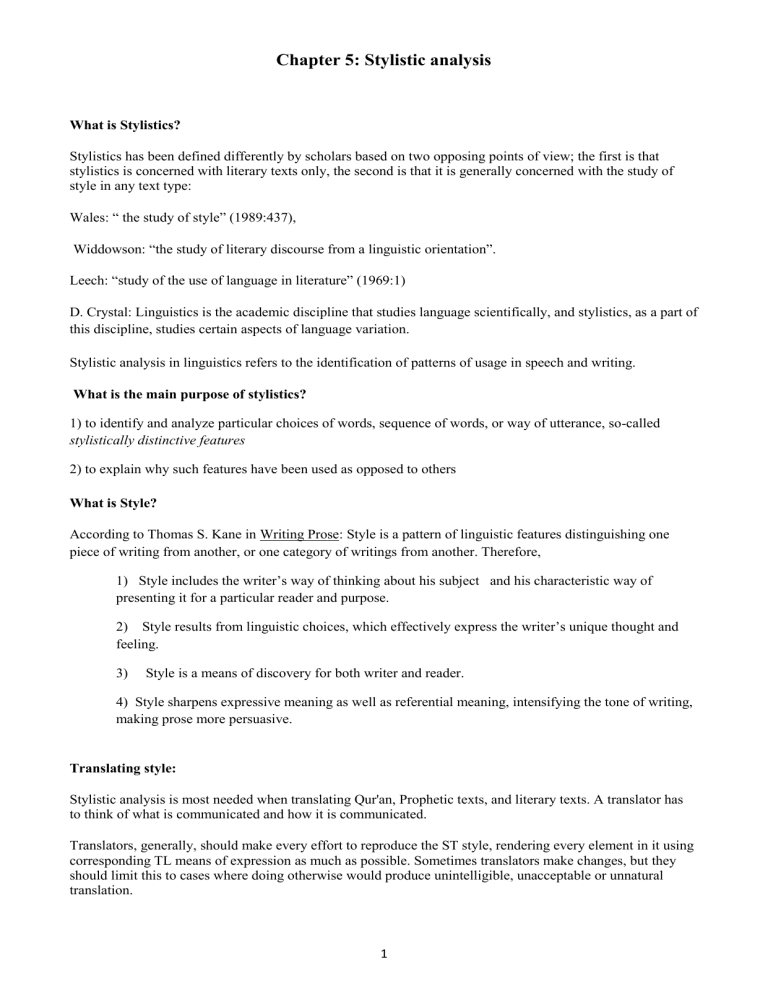
Chapter 5: Stylistic analysis
What is Stylistics?
Stylistics has been defined differently by scholars based on two opposing points of view; the first is that stylistics is concerned with literary texts only, the second is that it is generally concerned with the study of style in any text type:
Wales: “ the study of style” (1989:437),
Widdowson: “the study of literary discourse from a linguistic orientation”.
Leech: “study of the use of language in literature” (1969:1)
D. Crystal: Linguistics is the academic discipline that studies language scientifically, and stylistics, as a part of this discipline, studies certain aspects of language variation.
Stylistic analysis in linguistics refers to the identification of patterns of usage in speech and writing.
What is the main purpose of stylistics?
1) to identify and analyze particular choices of words, sequence of words, or way of utterance, so-called stylistically distinctive features
2) to explain why such features have been used as opposed to others
What is Style?
According to Thomas S. Kane in Writing Prose: Style is a pattern of linguistic features distinguishing one piece of writing from another, or one category of writings from another. Therefore,
1) Style includes the writer’s way of thinking about his subject and his characteristic way of presenting it for a particular reader and purpose.
2) Style results from linguistic choices, which effectively express the writer’s unique thought and feeling.
3) Style is a means of discovery for both writer and reader.
4) Style sharpens expressive meaning as well as referential meaning, intensifying the tone of writing, making prose more persuasive.
Translating style:
Stylistic analysis is most needed when translating Qur'an, Prophetic texts, and literary texts. A translator has to think of what is communicated and how it is communicated.
Translators, generally, should make every effort to reproduce the ST style, rendering every element in it using corresponding TL means of expression as much as possible. Sometimes translators make changes, but they should limit this to cases where doing otherwise would produce unintelligible, unacceptable or unnatural translation.
1
To be able to produce a stylistically equivalent translation, the translator has to explore the style of the ST. there are various models for stylistic analysis proposed by different researchers. In this chapter will look at two models: 1) Leech and Short (1981) which is a bit detailed. 2) Hilkka Pekkanen (2010) which is a very simple one.
A CHECKLIST for STYLISTIC analysis (Leech and Short, 2001)
The categories are placed under four general headings: lexical categories, grammatical categories, figures of speech, and cohesion and context. Semantic categories are not listed separately, since it is easier to arrive at these through other categories; we shall, for example, use our lexical categories to find out how choice of words involves various types of meaning. Since the purpose of the list is heuristic, there is no harm in ‘mixing categories’ in this way. It is also in the nature of things that categories will overlap, so that the same feature may well be noted under different headings.
A: Lexical categories
1.GENERAL. Is the vocabulary simple or complex? formal or colloquial? descriptive or evaluative? general or specific? How far does the writer make use of the emotive and other associations of words, as opposed to their referential meaning? Does the text contain idiomatic phrases, and if so, with what kind of dialect or register (iii) are these idioms associated? Is there any use of rare or specialized vocabulary? Are any particular morphological categories noteworthy (e.g. compound words, words with particular suffixes)? To what semantic fields do words belong?
2 NOUNS. Are the nouns abstract or concrete? What kinds of abstract nouns occur (e.g. nouns referring to events, perceptions, processes, moral qualities, social qualities)? What use is made of proper names? collective nouns?
3 ADJECTIVES. Are the adjectives frequent? To what kinds of attribute do adjectives refer? physical? psychological? visual? auditory? color? referential? emotive? evaluative? etc. Are adjectives restrictive or non-restrictive? gradable or non— gradable? attributive or predicative?
4 VERBS. Do the verbs carry an important part of the meaning? Are they stative (referring to states) or dynamic (referring to actions, events, etc)? Do they 'refer' to movements, physical acts speech acts, psychological states or activities, perceptions, etc? Are they transitive, intransitive, linking (intensive), etc?
Are they factive or non-factive (iv)?
5 ADVERBS. Are adverbs frequent? What semantic functions do they perform (manner, place, direction, time, degree, etc)? Is there any significant use of sentence adverbs (conjuncts such as so, therefore, however; disjuncts such as certainly, obviously, frankly) (v)?
B:Grammatical categories
I SENTENCE TYPES. Does the author use only statements (declarative sentences), or does he also use questions, commands, exclamations. or minor sentence types such as sentences with no verb)? If these other types are used, what is their function?
2 SENTENCE COMPLEXITY . Do sentences on the whole have a simple or a complex structure? What is the average sentence length (in number of words)? What is the ratio of dependent to independent clauses complexity vary strikingly from one sentence to another? Is complexity mainly due to (i) coordination, (ii) subordination, (iii) parataxis (juxtaposition of clauses or other equivalent structures)? In what parts of a sentence does complexity tend to occur? For instance, is there any notable occurrence of anticipatory structure
(e.g. of complex subjects preceding the verbs, of dependent clauses preceding the subject of a main clause)?
2
3 CLAUSE TYPES.
What types of dependent clause are favored:relative clauses, adverbial clauses, different types of nominal clauses (that—clauses, wh—clauses, etc)? Are reduced or non-finite clauses commonly used, and if so, of what type are they (infinitive clauses, —ing clauses, —ed clauses, verbless clauses)?
4 CLAUSE STRUCTURE.
Is there anything significant about clause elements (eg frequency of objects, complements, adverbials; of transitive or intransitive verb constructions)? Are there any unusual orderings
(initial adverbials, fronting of object or complement, etc)? Do special kinds of clause construction occur?
(Such as those with preparatory it or there)?
5 NOUN PHRASES.
Are they relatively simple or complex? Where does the complexity lie (in premodification by adjectives, nouns, etc, or in post-modification by prepositional phrases, relative clauses, etc)?
Note occurrence of listings (eg sequences of adjectives), coordination, or apposition.
6 VERB PHRASES.
Are there any significant departures from the use of the simple past tense? For example, notice occurrences and the functions of the present tense; of the progressive aspect (eg was lying); of the perfective aspect (eg has/had appeared); o modal auxiliaries (eg can, must, would, etc).
7 OTHER PHRASE TYPES.
Is there anything to be said about other phrase types: prepositional phrases, adverb phrases adjective phrases?
8 WORD CLASSES.
Having already considered major or lexical word classes, we may here consider minor word classes (‘function words’): prepositions, conjunctions, pronouns, determiners, auxiliaries, interjections.
Are particular words of these types used for particular effect (eg the definite or indefinite article; first person pronouns I, we, etc; demonstratives such as this and that; negative words such as not, nothing, no) ?
9 GENERAL.
Note here whether any general types of grammatical construction are used to special effect e.g. comparative or superlative constructions; coordinative or listing constructions; parenthetical. constructions; appended or interpolated structures such as occur in casual speech. Do lists and co-ordinations (e.g. lists of nouns) tend to occur with two, three or more than three members?
C: Figures of speech, etc
Here we consider the incidence of features which are fore-grounded by virtue of departing in some way from general norms of communication by means of the language code; for example, exploitation of regularities of formal patterning, or of deviations from the linguistic code. For identifying such features, the traditional figures of speech (schemes and tropes) are often useful categories.
1 GRAMMATICAL AND LEXICAL SCHEMES.
Are there any cases of formal and structural repetition
(anaphora, parallelism, etc) or of mirror—image patterns (chiasmus)? Is the rhetorical effect of these one of antithesis, reinforcement, climax, anticlimax, etc
2 PHONOLOGICAL SCHEMES.
Are there any phonological patterns of rhyme ...alliteration, assonance, etc? Are there any salient rhythmical patterns? Do vowel and consonant sounds pattern or cluster in particular ways? How do these phonological features interact with meaning?
3 TROPES.
Are there any obvious violations of, or departures from the linguistic code? For example, are there any neologisms (such as Americanly)? deviant lexical collocations (such as portentous infants)? semantic, syntactic, phonological, or graphological deviations?
Such deviations will often be the clue to special interpretations associated with traditional figures of speech such as metaphor, metonymy, synecdoche, paradox, irony ~t If such tropes occur, what kind of special interpretation is involved (eg metaphor can be classified as personifying, animizing, concretizing, synaesthetic, etc)? Because of its close connection with metaphor, simile may also be considered here. Does the text contain any similes, or similar constructions (eg ‘as if’ constructions)? What dissimilar semantic fields are related through simile?
3
D: Context and cohesion
Finally, we take a preliminary look at features which will be more fully dealt with in the following. Under
COHESION ways in which one part of a text is linked to another are considered: for example, the wan which sentences are connected, This is the internal organization of the text. Under CONTEXT we consider the external relations of a text or a part of a text, seeing it as a discourse presupposing a social relation between its participants (author and reader; character and character, etc), and a sharing by participants of knowledge and assumptions.
1 COHESION.
Does the text contain logical or other links between sentences (eg coordinating conjunctions, or linking adverbials)? Or does it tend to rely on implicit connections of meaning?
What sort of use is made of cross-reference by pronouns (she, it, they, etc)? by substitute forms (do, so, etc), or ellipsis? Alternatively, is any use made of elegant variation — the avoidance of repetition by the substitution of a descriptive phrase (as, for example, ‘the old lawyer’ or ‘her uncle’ may substitute for the repetition of an earlier ‘Mr. Jones’)?
Are meaning connections reinforced by repetition of words and phrases or by repeatedly using words from the same semantic field?
2 CONTEXT.
Does the writer address the reader directly, or through the words or thoughts of some fictional character? What linguistic clues (first-person pronouns I, me, my, mine) are there of the addresser-addressee relationship? What attitude does the author imply towards his subject 3 If a character’s words or thoughts are represented, is this done by direct quotation: direct speech), or by some other method (eg indirect speech. free indirect speech)? Are there significant changes of style according to who is supposedly speaking or thinking the words on the page?
Examples:
A poem by Coleridge
The fair breeze blew, the white foam flew,
The furrow followed free;
We were the first that ever burst
Into that silent sea.
These lines depend on alliteration in communicating the sense of movement and conveying auditory images with the repetition of the sounds f, b, w . Then in the last line, the poet shifts to describe silence with the sound s .
Think of sounds in Arabic that communicate the same senses.
A passage from Hemingway's Old Man and the Sea:
ST
TT
He was an old man who fished alone in a skiff in the Gulf Stream and he had gone eighty-four days now without taking a fish. In the first forty days, a boy had been with him.
،ةعاسل ا ىتح هب تربع دق و ."ميرتس دلوج" جيلخ ىف ديصلا بلطي ،ًاديحو ،هقروز ىف ًاضبار لازي لا هنكل ..
ايتع ربكلا نم غلب دق لجرلا ناك
.هرمأ ىلع هنيعي ملاغ هل ناك ،اهنم ىلولأا نيعبرلأا مايلأا ىف .قزرلا نم ءىشب اهللاخ رحبلا هيلع دجي مل ًاموي نونامث و ةعبرأ
Back translation
[The man has reached quite an old age. But he was still lying down in his boat, alone, seeking to fish in the gulf of Gulf Stream. Up to this hour, forty eight days have passed and the sea has not granted him any blessings. In the first forty days he had a lad who helped him in his affair.] (Qinai)
نيسح مادصل باطخ
ST
لقث تحت نوحزري اوراصو ،هيلع اوناك ام ىلع ارقفو ،امهو ،امغ سانلا دادزا كلذبو ،سانلا تاريخ ابهان ،ايدتعم ،ابصتغم ،ارمعتسم برغلا ءاج
ةلئاط تايحض ت دعب لاإ ،اهرمعتساو ايركسع اهلتحا يتلا ،رايدلا نع برغلا ولجي ملو ،يرامعتسلااو يركسعلا للاتحلاا مهيلع اهبتر ،ةيفاضإ ءابعأ
،اهئانبلأ
T1 ... the West were here as colonists, usurpers, aggressors and plunders of the people’s resources. Therefore, the people became poorer and more worried and distressed than they were, and now they are languishing under the
4
weight of additional burdens, forced on them by the colonial military occupation. The West did not leave the land which it had occupied and colonized by its military forces, only after enormous and great sacrifices of its sons
[people]
T2 ... the West came to colonize, to usurp, to assault, to invade and to steal people’s resources. Consequently, the people became poorer and more worried and distressed than they were, and now they are languishing under the weight of additional burdens, forced on them by the colonizing military occupation. The West left the land, occupied and colonized by its military forces, but only after enormous and great sacrifices of its citizens.
President Obama’s speech on Iraq withdrawal, delivered on February 27, 2009:
ST You are a great nation , rooted in the cradle of civilization . You are joined together by enduring accomplishments, and a history that connects you as surely as the two rivers carved into your land . In years past, you have persevered through tyranny and terror ; through personal insecurity and sectarian violence. And instead of giving in to the forces of disunion , you stepped back from a descent into civil war , and showed a proud resilience that deserves respect.
T1
T2
T3
دقل ،مكضرأ يف نيميظعلا نيرهنلل ديكأت لكب اعم مكطبري خيرات و ةخسار تازاجنإب اعم متدحتا دقل ،ةراضحلا دهم نم اهروذج تعبن ةميظع ةمأ مكنإ
دقلف لاصفن لاا ىوقل ملاستسلاا نم لادب و يفئاطلا فنعلا و يصخشلا نملأا نادقف دض باهرلإا و نايغطلا ةهجاوم يف ةقباسلا تاونسلا يف متدمص
مارتحلاا قح تست اهب رخفي ةنورم مترهظأ و ةيلهلأا برحلا و ةيلبقلا نم ءارولا ىلإ متعجارت
ناقشي نيذللا ني رهنلا خوسرك مكنيب طبري خسار خيرات و مكلمحت ةوق زربت تازاجنإ ايوس مكعمجي امك ،تاراضحلا دهمل مكروذج دتمت و ةميظع ةمأ متنأ
ةقرفتلا لماوعل اوم لستست نأ ن م لادب و يفئاطلا فنعلا و يصخشلا نملأا رفوت دع يف لثمت يذلا باهرلإا و ملظلا دض يضاملا يف متدمص دقل ،مكضرأ
ةداشلإا قحتست و اهب رختفي ةمواقم متيدبأ و ةيلهلأا برحل يدرتلا نع متعجارت دقلف
نيرهنلاب اننيقيك كلذ نم نيقي ىلع نحن و ميظع خيرات ديكأتلاب مكنيب طبري و ،بضنت لا تازاجنإ مكعمجي .ةميدق ةيراضح روذج اهل ةميظع ةمأ متنأ
لادب و .يفئاطلا فنعلا مغر و يصخشلا نملأا مادعنا مغر ،باهرلإا و نايغطلا مغر ةيضاملا تاونسلا للاخ ءاقبلا متعطتسا دقل ،مكضرأ ن اقشي نيذللا
.مارتحلاا قحتست ةمواقم متيدبأ و ةيلهأ برح يف طوقسلا نع متعجارت ،قرفتلا ىوقل اوملستست نأ نم
Style factors
(Hilkka Pekkanen, 2010)
1) Degree of specification
This means the amount and accuracy of information provided by the translator for the reader. The translator has to think about all the meanings implied by a word or a structure, and try to capture these meanings in the expression he chooses from the TL.
Example 1 : The girl jotted down her address on the paper.
ةقرولا ىلع اهناونع ةاتفلا تبتك
Example 2 : 260 ةرقبلا "ايعس كنيتأي نهعدا مث"
Ahmed Ali: "and they will come flying to you."
Ahmed Raza Knan: "they will come running towards you"
Arberry: "and they will come to thee running."
Asad: "they will come flying to thee."
Hilali and Khan: "they will come to you in haste."
Maududi: "and they will come running to you"
Pickthall: "they will come to thee in haste"
Yusuf: "They will come swiftly to you"
2) Order of presentation
The order of presentation may refer to the ordering of the entire subject matter of a novel, but at the microlevel, sequential arrangements of linguistic units may also affect focalization by directing the attention of the reader, altering the focus and emphasis and producing rhythmical effects, for example.
Example 3 : We went into the restaurant, passed Madame Lavigne at the desk and into a little room.
(Hemingway 1926: 14)
ةريغص ةفرغ انلخد مث اهبتكم ىلع جنيفلا ةديسلاب انررم و معطملا ىلإ انبهذ
اهبتكم ىلع سلجت يتلا جنيفلا ةديسلاب ارورم ةريغص ةفرغ انلخد ىتح انتلحر انلصاو و معطملا ىلإ انبهذ
5
.ةريغص ةفرغ انلخد مث اهبتكم ىلع جنيفلا ةديسلاب انررم انقيرط يف و معطملا انلخد
3) focalization (point of view and attitude, distance, focus and emphasis)
Focalization may also take the form of directing focus (drawing attention to certain elements or hiding other elements) and giving additional emphasis through sequential or referential arrangements. A wide range of tools is available for focalization purposes at the linguistic level: both semantic-level and syntactic-level choices, interplay between transitivity and agency, reference and cohesion. Example (3) shows one way in which point of view or focus may shift in translation.
Example 4 : His tri-cornered hat was low down over his eyes. (Hemingway 1926: 162)
هينيع ىلع ةضفخنم اياوزلا ةيثلاث هتعبق تناك
.هينيع ىلع اياوزلا ةيثلاث هتعبق لزنأ
هينيع ىلع ةيخرم ثلاثلا اياوزلا تاذ هتعبق تناك
هينيع ىلع اياوزلا ةيثلاث هتعبق ىخرأ
Example 5 : …his eyes had wandered… (Joyce 1916: 140)
هلوح اميف هانيع تلاج و
هلوح اميف هرظن لاجأ و
هلوح اميف لوجي هرظنل نانعلا كرت و
Example 6 : I first became aware of his lady’s attitude… (Hemingway 1926: 7)
ةرم لولأ هتديس فقوم تكردأ
ةرم لولأ يل احضاو هتديس فقوم حبصأ
ةرم لولأ هتديس فقومب تملع
Example 7 : Robert Cohn was a member, through his father, of one of the richest Jewish families in New
York, and through his mother of one of the oldest. (Hemingway 1926: 5)
اهمدقأ ىلإ همأ فرط نم و كروي وين يف ةيدوهيلا رسلأا ىنغأ ىدحإ ىلإ يمتني هيبأ فرط نم نوك ناك
اهمدقأ نم ةدحاو يف همأ قيرط نم و كروي نوين يف ةيدوهيلا رسلأا ىنغأ نم ةدحاو يف هيبا قيرط نم اوضع نوك ناك
.اهي ف ةقيرعلا رسلأا ىدحإ دارفأ ىدحإ اضيأ همأ تناك و كروي نوين يف ةيدوهيلا رسلأا ىنغأ نم ةدحاو يف هيبا قيرط نم اوضع نوك ناك
همأ فرط نم اهرسأ قرعأ نم ةدحاو ىلإ و هيبأ فرط نم كروي وين يف ةيدوهيلا رسلأا ىنغأ نم ةدحاو ىلإ يمتني نوك ناك
6
